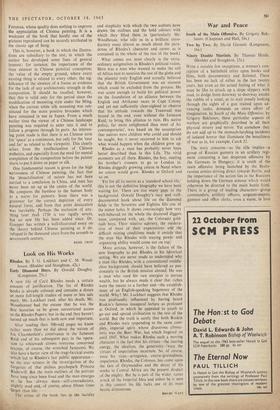Formalist Millennium
The Essence of Chinese Painting. By Roger Goepper. Translated by Michael Bullock. (Lund Humphries, £5 12s. 6d.)
IT is only fifty-five years since the first book in a European language on Chinese painting was published in London—Painting in the Far East, by Laurence Binyon. Now several are brought out every year in each of the principal Western languages; but it may be doubted whether general understanding of the subject has increased proportionately. There are too few opportunities of seeing paintings of quality for it to be easy to gain a first-hand appreciation. It is against this background that it should be said that the book here noticed has substantial merits.
Dr. Goepper writes only of paintings which he has actually studied for himself; which is by no means the rule, even in more ambitious publications. He provides among his illustrations a good proportion of details reproduced to the scale of the original paintings from photographs taken under his own direction. This is achieved by limiting the basis to the 150 pictures chosen from collections in Europe and America for ' exhibition in Munich in 1959, by the author with the assistance of a small international com- mittee of experts. These provide virtually all the half-tone illustrations, to which there have been added fifteen colour-plates including six from the imperial Chinese collection now in Formosa, whose quality does nothing to improve the appreciation of Chinese painting. It is a weakness of the book that hardly one of the pictures reproduced can be securely attributed to the classic age of Sung.
This is, however, a book in which the illustra- tions are subsidiary to the text, in which the author has developed some lines of general interest: for instance, the importance of the time element in Chinese pictorial conception; the value of the empty ground, where every existing thing is related to every other; the sig- nificance of the absence of a frame as evidence for the lack of any architectonic strength in the composition. It should be recalled, however, that this is valid only for the period since the modification of mounting style under the Ming, when the current white silk mounting was sub- stituted for the more positive brocades which have remained in use in Japan. From a much earlier time the viewer of a Chinese landscape painting was required to enter into it and to follow a progress through • its parts. An interest- ing point made is that there is no Chinese term for 'space' as a continuum, but only for the `near and far' as related to the viewpoint. This clearly arises from the intellectualism of Chinese esthetics, and especially from the need for mental completion of the composition before the painter starts to put it down on paper or silk.
One fundamental reason is given for the high seriousness of Chinese painting, the fact that the `desacralisation' of nature has not been carried to a conclusion in China, and man has never been set up as the centre of the world. He compares the bamboo to the human body as a norm for painters. Soon there was a grammar for• the correct depiction of every natural form; and from that point desiccation was inevitable. Perhaps the exclusion of any- thing later than 1750 is too rigidly severe, but no new life has been added since. Dr. Goepper has written a well-illustrated essay on the theory behind Chinese painting as it de- veloped in the thousand years from the seventh to seventeenth century.
BASIL GRAY



































 Previous page
Previous page